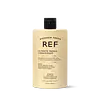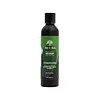What's inside
What's inside
 Key Ingredients
Key Ingredients

 Benefits
Benefits

 Concerns
Concerns

 Ingredients Side-by-side
Ingredients Side-by-side

Water
Skin ConditioningCetearyl Alcohol
EmollientBehentrimonium Chloride
PreservativeCetrimonium Chloride
AntimicrobialAmodimethicone
Cetyl Esters
EmollientPhenoxyethanol
PreservativeCaprylic/Capric Triglyceride
MaskingLinum Usitatissimum Seed Oil
PerfumingParfum
MaskingPanthenol
Skin ConditioningAstrocaryum Murumuru Seed Butter
EmollientCitric Acid
BufferingEthylhexylglycerin
Skin ConditioningQuaternium-95
UV AbsorberArginine
MaskingTocopherol
AntioxidantButylene Glycol
HumectantGlycerin
HumectantLimonene
PerfumingPropanediol
SolventHexyl Cinnamal
PerfumingHelianthus Annuus Seed Extract
Skin ConditioningHydrolyzed Quinoa
Skin ConditioningBHT
AntioxidantPEG-8
HumectantHydrolyzed Vegetable Protein Pg-Propyl Silanetriol
Skin ConditioningCitral
PerfumingLinalool
PerfumingPEG-8/Smdi Copolymer
Palmitoyl Myristyl Serinate
Skin ConditioningSodium Polyacrylate
AbsorbentWater, Cetearyl Alcohol, Behentrimonium Chloride, Cetrimonium Chloride, Amodimethicone, Cetyl Esters, Phenoxyethanol, Caprylic/Capric Triglyceride, Linum Usitatissimum Seed Oil, Parfum, Panthenol, Astrocaryum Murumuru Seed Butter, Citric Acid, Ethylhexylglycerin, Quaternium-95, Arginine, Tocopherol, Butylene Glycol, Glycerin, Limonene, Propanediol, Hexyl Cinnamal, Helianthus Annuus Seed Extract, Hydrolyzed Quinoa, BHT, PEG-8, Hydrolyzed Vegetable Protein Pg-Propyl Silanetriol, Citral, Linalool, PEG-8/Smdi Copolymer, Palmitoyl Myristyl Serinate, Sodium Polyacrylate
Water
Skin ConditioningGlycerin
HumectantBetaine
HumectantCetearyl Alcohol
EmollientCetyl Alcohol
EmollientBis-Octyldodecyl Dimer Dilinoleate/Propanediol Copolymer
EmollientLinum Usitatissimum Seed Extract
PerfumingBrassicamidopropyl Dimethylamine
Skin ConditioningRosmarinus Officinalis Leaf Oil
MaskingCaffeine
Skin ConditioningMentha Piperita Oil
MaskingSerenoa Serrulata Fruit Extract
Skin ConditioningCeramide NP
Skin ConditioningCopper Tripeptide-1
Skin ConditioningCopper Tripeptide-34
Skin ConditioningBiotin
AntiseborrhoeicInositol
HumectantPhytosterols
Skin ConditioningMenthol
MaskingMelatonin
AntioxidantLactic Acid
BufferingSarcosine
Skin ConditioningPolyglyceryl-10 Laurate
Skin ConditioningPotassium Olivate
EmulsifyingCaprylhydroxamic Acid
Caprylyl Glycol
EmollientSodium Benzoate
MaskingPotassium Sorbate
PreservativeWater, Glycerin, Betaine, Cetearyl Alcohol, Cetyl Alcohol, Bis-Octyldodecyl Dimer Dilinoleate/Propanediol Copolymer, Linum Usitatissimum Seed Extract, Brassicamidopropyl Dimethylamine, Rosmarinus Officinalis Leaf Oil, Caffeine, Mentha Piperita Oil, Serenoa Serrulata Fruit Extract, Ceramide NP, Copper Tripeptide-1, Copper Tripeptide-34, Biotin, Inositol, Phytosterols, Menthol, Melatonin, Lactic Acid, Sarcosine, Polyglyceryl-10 Laurate, Potassium Olivate, Caprylhydroxamic Acid, Caprylyl Glycol, Sodium Benzoate, Potassium Sorbate
Ingredients Explained
These ingredients are found in both products.
Ingredients higher up in an ingredient list are typically present in a larger amount.
Cetearyl alcohol is a mixture of two fatty alcohols: cetyl alcohol and stearyl alcohol. It is mainly used as an emulsifier. Emulsifiers help prevent the separation of oils and products. Due to its composition, it can also be used to thicken a product or help create foam.
Cetearyl alcohol is an emollient. Emollients help soothe and hydrate the skin by trapping moisture.
Studies show Cetearyl alcohol is non-toxic and non-irritating. The FDA allows products labeled "alcohol-free" to have fatty alcohols.
This ingredient is usually derived from plant oils such as palm, vegetable, or coconut oils. There is debate on whether this ingredient will cause acne.
Due to the fatty acid base, this ingredient may not be Malassezia folliculitis safe.
Learn more about Cetearyl AlcoholGlycerin is already naturally found in your skin. It helps moisturize and protect your skin.
A study from 2016 found glycerin to be more effective as a humectant than AHAs and hyaluronic acid.
As a humectant, it helps the skin stay hydrated by pulling moisture to your skin. The low molecular weight of glycerin allows it to pull moisture into the deeper layers of your skin.
Hydrated skin improves your skin barrier; Your skin barrier helps protect against irritants and bacteria.
Glycerin has also been found to have antimicrobial and antiviral properties. Due to these properties, glycerin is often used in wound and burn treatments.
In cosmetics, glycerin is usually derived from plants such as soybean or palm. However, it can also be sourced from animals, such as tallow or animal fat.
This ingredient is organic, colorless, odorless, and non-toxic.
Glycerin is the name for this ingredient in American English. British English uses Glycerol/Glycerine.
Learn more about GlycerinWater. It's the most common cosmetic ingredient of all. You'll usually see it at the top of ingredient lists, meaning that it makes up the largest part of the product.
So why is it so popular? Water most often acts as a solvent - this means that it helps dissolve other ingredients into the formulation.
You'll also recognize water as that liquid we all need to stay alive. If you see this, drink a glass of water. Stay hydrated!
Learn more about Water